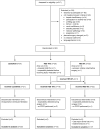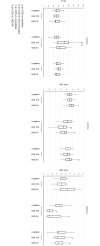In vivo effects of balanced, low molecular 6% and 10% hydroxyethyl starch compared with crystalloid volume replacement on the coagulation system in major pancreatic surgery-a sub-analysis of a prospective double-blinded, randomized controlled trial
- PMID: 38991044
- PMCID: PMC11239059
- DOI: 10.1371/journal.pone.0303165
In vivo effects of balanced, low molecular 6% and 10% hydroxyethyl starch compared with crystalloid volume replacement on the coagulation system in major pancreatic surgery-a sub-analysis of a prospective double-blinded, randomized controlled trial
Abstract
Background: The outcome of patients undergoing major surgery treated with HES for hemodynamic optimization is unclear. This post-hoc analysis of a randomized clinical pilot trial investigated the impact of low-molecular balanced HES solutions on the coagulation system, blood loss and transfusion requirements.
Methods: The Trial was registered: EudraCT 2008-004175-22 and ethical approval was provided by the ethics committee of Berlin. Patients were randomized into three groups receiving either a 10% HES 130/0.42 solution, a 6% HES 130/0.42 solution or a crystalloid following a goal-directed hemodynamic algorithm. Endpoints were parameters of standard and viscoelastic coagulation laboratory, blood loss and transfusion requirements at baseline, at the end of surgery (EOS) and the first postoperative day (POD 1).
Results: Fifty-two patients were included in the analysis (HES 10% (n = 15), HES 6% (n = 17) and crystalloid (n = 20)). Fibrinogen decreased in all groups at EOS (HES 10% 338 [298;378] to 192 [163;234] mg dl-1, p<0.01, HES 6% 385 [302;442] to 174 [163;224] mg dl-1, p<0.01, crystalloids 408 [325;458] to 313 [248;370] mg dl-1, p = 0.01). MCF FIBTEM was decreased for both HES groups at EOS (HES 10%: 20.5 [16.0;24.8] to 6.5 [5.0;10.8] mm, p = <0.01; HES 6% 27.0 [18.8;35.2] to 7.0 [5.0;19.0] mm, p = <0.01). These changes did not persist on POD 1 for HES 10% (rise to 16.0 [13.0;24.0] mm, p = 0.88). Blood loss was not different in the groups nor transfusion requirements.
Conclusion: Our data suggest a stronger but transient effect of balanced, low-molecular HES on the coagulation system. Despite the decline of the use of artificial colloids in clinical practice, these results may help to inform clinicians who use HES solutions.
Copyright: © 2024 Eckers et al. This is an open access article distributed under the terms of the Creative Commons Attribution License, which permits unrestricted use, distribution, and reproduction in any medium, provided the original author and source are credited.
Conflict of interest statement
I have read the journal’s policy and the authors of this manuscript have the following competing interests: Alexander Eckers, Oliver Hunsicker and Kerstin Rubarth have declared that no competing interests exist. Claudia Spies has received research funding from B.Braun during the study DOI: 10.1097/MD.0000000000010579. Outside the submitted manuscript she has received research funding and honoraria from German Research Society (DFG), German Aerospace Center (DLR), Einstein Foundation Berlin, German Federal Joint Commitee (G-BA), Inner University grants, Project Management Agency (DLR), Stifterverband, European Society of Anaesthesiology and Intensive Care, German Federal Ministry of Economic Affairs and Climate Action, Georg Thieme Verlag, Dr. F. Köhler Chemie GmbH, Sintetica GmbH, Max-Planck-Gesellschaft zur Förderung der Wissenschaften e.V., Stifterverband für die deutsche Wissenschaft e.V./Metronic, Philips Electronics Nederland BV, BMBF/RKI, G-BA Innovationsfonds outside the submitted work. In addition, Dr. Spies has following patents licensed: 10 2014 215 211.9; 10 2018 114 364.8; 10 2018 110 275.5; 50 2015 010 534.8; 50 2015 010 347.7; 10 2014 215 212.7. Felix Balzer has received research grants from Einstein Foundation, German Federal Ministry of Education and Research, German Federal Ministry of Health, Berlin Institute of Health, Hans Böckler Stiftung, Berlin university Alliance, as well as honoraria from Medtronic, GE outside this work. Christian von Heymann has received honoraria from Artcline GmbH, CSL Behring, Daiichi Sankyo, HICC GbR, Mitsubishi Pharma, Novo Nordisk, Sobi Pharma and Shionogi Pharma that were not related to the topic of this work. This does not alter our adherence to PLOS ONE policies on sharing data and materials.
Figures


Similar articles
-
Balanced 10% hydroxyethyl starch compared with balanced 6% hydroxyethyl starch and balanced crystalloid using a goal-directed hemodynamic algorithm in pancreatic surgery: A randomized clinical trial.Medicine (Baltimore). 2018 Apr;97(17):e0579. doi: 10.1097/MD.0000000000010579. Medicine (Baltimore). 2018. PMID: 29703051 Free PMC article. Clinical Trial.
-
Effect of hydroxyethyl starch 130/0.4 on blood loss and coagulation in patients with recent exposure to dual antiplatelet therapy undergoing off-pump coronary artery bypass graft surgery.Circ J. 2011;75(10):2397-402. doi: 10.1253/circj.cj-11-0404. Epub 2011 Aug 2. Circ J. 2011. PMID: 21817820 Clinical Trial.
-
[Rotational thromboelastometry assessment of ballanced crystalloid, hydroxyethyl starch and gelatin effects on coagulation: a randomized trial].Braz J Anesthesiol. 2019 Jul-Aug;69(4):383-389. doi: 10.1016/j.bjan.2019.03.009. Epub 2019 Aug 9. Braz J Anesthesiol. 2019. PMID: 31405567 Free PMC article. Clinical Trial.
-
Hydroxyethyl Starch for Fluid Management in Patients Undergoing Major Abdominal Surgery: A Systematic Review With Meta-analysis and Trial Sequential Analysis.Anesth Analg. 2022 Apr 1;134(4):686-695. doi: 10.1213/ANE.0000000000005803. Anesth Analg. 2022. PMID: 34854822
-
Safety and efficacy of tetrastarches in surgery and trauma: a systematic review and meta-analysis of randomised controlled trials.Br J Anaesth. 2021 Oct;127(4):556-568. doi: 10.1016/j.bja.2021.06.040. Epub 2021 Jul 28. Br J Anaesth. 2021. PMID: 34330414
References
-
- Myles PS, Bellomo R, Corcoran T, Forbes A, Peyton P, Story D, et al.; Australian and New Zealand College of Anaesthetics Clinical Trials Network and the Australian and New Zealand Intensive Care Society Clinical Trials Group. Restrictive versus Liberal Fluid Therapy for Major Abdominal Surgery. N Engl J Med. 2018. Jun 14;378(24):2263–2274. doi: 10.1056/NEJMoal1801601 - DOI - PubMed
-
- Lassen K, Soop M, Nygren J, Cox PB, Hendry PO, Spies C, et al.; Enhanced Recovery After Surgery (ERAS) Group. Consensus review of optimal perioperative care in colorectal surgery: Enhanced Recovery After Surgery (ERAS) Group recommendations. Arch Surg, 2009. Oct;144(10):961–9. doi: 10.1001/archsurg.2009.170 - DOI - PubMed
-
- Joosten A, Delaporte A, Ickx B, Touihri K, Stany I, Barvais L, et al.. Crystalloid versus Colloid for Intraoperative Goal-directed Fluid Therapy Using a Closed-loop System: A Randomized, Double-blinded, Controlled Trial in Major Abdominal Surgery. Anesthesiology. 2018. Jan;128(1):55–66. doi: 10.1097/ALN.0000000000001936 - DOI - PubMed
Publication types
MeSH terms
Substances
LinkOut - more resources
Full Text Sources

